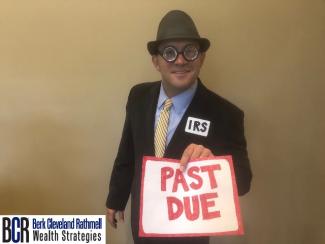
If You Fail to Take an RMD
Investing in a tax-deferred retirement account is a great way to save for retirement because deferring taxes can provide a big boost to the amount you’re able to save during your working years. Many people save significantly more than they could otherwise by using these accounts, but they don’t come without “strings” forever. Just in case you aren’t familiar with how they work, I’ll explain.
The government says that if you're willing to save for retirement, they are willing to help you out during your working years by letting you not pay taxes on a portion of your income if you invest it in certain types of retirement accounts.
But you aren’t allowed to avoid paying taxes on that income indefinitely. Once you reach age 70 ½, you are required to begin withdrawing money from the account every year, and pay taxes on it.
Even if you aren’t 70 ½ yet, you must withdraw money if you have inherited one of these accounts. This is because these accounts begin to become taxable upon the owner’s death.
The amount you are required to withdraw is called the Required Minimum Distribution (RMD). Your investment advisor, financial institution, or online calculators can help you determine the amount you're required to pull out.
You can spend this money, but you don’t have to. It may be wiser, especially if you have inherited an account, to do something else, like move it to another investment account that is taxable, convert it to a Roth IRA or donate it.
If you fail to take your RMD
There are stiff penalties if you fail to take an RMD or you miscalculate it: you must pay an additional 50% taxes on the amount you should have withdrawn plus withdraw and make the tax payment you should have in the first place.
One critical bit of information to know is that the individual taxpayer is solely responsible for complying with this requirement. While financial advisors or institutions can help you calculate your RMD, they are not legally obligated to make sure you withdraw the funds or even notify you that you are subject to the requirement.
We at BCR® monitor this because we believe it is a service we should provide! We have unfortunately had to assist several new clients who failed to take their RMDs because they were unaware of the requirement, and their previous advisor had not assisted them with meeting it or even brought it to their attention. In such cases, we have had success in helping get the penalty waived.
According to the IRS, “…the penalty may be waived if the account owner establishes that the shortfall in distributions was due to reasonable error and that reasonable steps are being taken to remedy the shortfall.”
If you have failed to take an RMD, you may be able to persuade the IRS to waive the penalty by:
- immediately withdrawing the RMD for every tax year in which it was required,
- paying the taxes for the current year and previous years’ RMDs, and
- filing Form 5329 with your tax return and attaching a letter explaining that you were unaware of the requirement, and asking for forgiveness.
Taking these steps demonstrates that you are taking the steps necessary to remedy the shortfall. The IRS takes such requests into consideration and many times will waive the penalty since the taxpayer is acknowledging an error and understands it cannot be made again.
If you’d like to know more about RMDs, the IRS has a robust list of answers to frequently-asked questions on their website. If you have questions about what you read there, consult a qualified financial professional.
-Marshall Rathmell-

